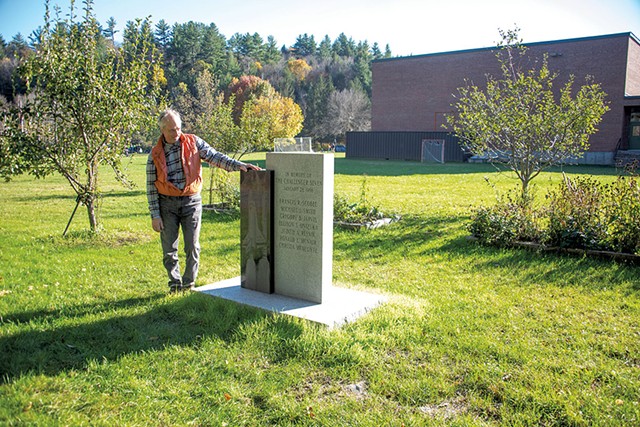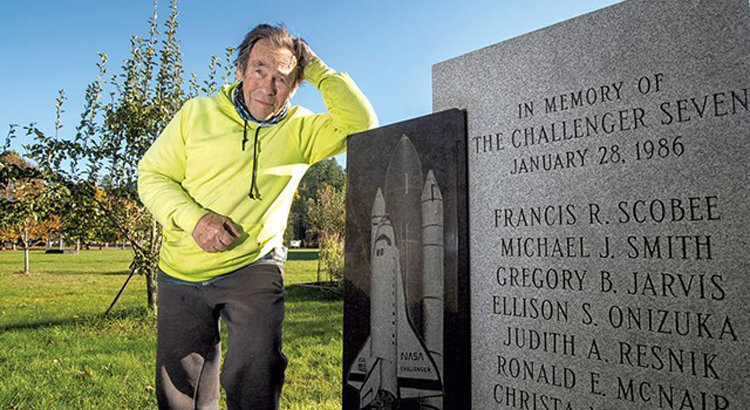Since 1986, drivers coming off I-89’s exit 8 sped past a granite monument at the base of National Life Drive. It memorialized the “Challenger Seven,” the astronauts, including New Hampshire teacher Christa McAuliffe, who perished when their space shuttle exploded after liftoff. National Life had maintained the monument for nearly 35 years until this fall…when it suddenly wasn’t there.
This story from Seven Days newspaper explains how the monument came to be and where it went. Read it below or on Seven Days’ website here.
‘Challenger Seven’ Monument Is Relocated in Montpelier
On January 28, 1986, the 17 students in Roger Crowley’s fifth-grade class at Union Elementary School in Montpelier, along with parents and other visitors, gathered in his classroom to watch the launch of the space shuttle Challenger.
The spacecraft crew included New Hampshire teacher Christa McAuliffe, with whom Crowley’s students had corresponded. She had sent his class an autographed poster, which hung in the school library. And Crowley’s students had prepared questions for McAuliffe that NASA was to transmit to her during the mission.
But the events that unfolded that day would shake the Montpelier classroom, the U.S. space program and the nation: Seventy-three seconds after the Challenger took off from Florida’s Kennedy Space Center, it blew apart in a fiery explosion, killing the seven people on board.
“That was probably the most difficult moment I had in teaching,” said Crowley, now 77 and retired in Florida. He taught for 35 years at Union. “We’re watching with all those people — and the tragedy happens. Everyone looks at the teacher. I was pretty upset.”
Six months later, for reasons that remain something of a mystery, Desilets Granite of Montpelier created a monument to honor the Challenger crew. The work, which has no official title, is informally called the “Challenger Seven.” It consists of two pieces.
The first is a granite marker inscribed with the words “In Memory of the Challenger Seven,” the date of the explosion and the names of the seven shuttle astronauts. The second component is a piece of black granite etched with a picture of the space shuttle.
Ed Epstein, a Montpelier artist who’s etched about 5,500 granite monuments, created the rendering of the Challenger. He has made portraits of children and dogs and pictures of deer in the woods — but only one spacecraft.
“It’s tragic, and it’s sad,” Epstein, 85, said of the Challenger explosion. “And we’re all part of that. We’re all part of these public disasters.”
The public art was installed at the base of the road that leads to National Life Group, just off Memorial Drive and not far from the highway exit. Challenger Memorial Park was built around the monument, though that small park no longer exists. The site is not easy to access — there’s no sidewalk or place to park. And so folks in cars and strolling downhill from the insurance company who saw (or didn’t see) the “Challenger Seven” might not have known what it was.
That changed in September, when the monument was moved to a more accessible site along the bike path near Montpelier High School. It will be rededicated during a ceremony on November 18. Anne Watson, the Montpelier mayor and a science teacher at Montpelier High School, is scheduled to speak.
She was a 5-year-old in Essex when the Challenger blew up and has no recollection of the event, she said. But she teaches about it. The explosion is one of several catastrophes her engineering students study, trying to unravel what occurred and looking for possible connections among such disasters.
“As someone who loves science, particularly astronomy, particularly physics, the work of NASA is really important,” Watson said. “And I’m really grateful for the work they do. I think it helps us explore what it means to be human and our place in the universe.”
She’s pleased by the monument’s new location. The bike path provides ample public access, and the school campus is an appropriate setting, Watson said.
“I don’t think it got the recognition or appreciation, the attention it deserved in its old location,” Watson added.
The effort to relocate “Challenger Seven” was spearheaded by Bob Hannum, an art conservator and member of Montpelier’s Public Art Commission. At an inaugural meeting two years ago, the commission had decided to survey the city’s works of public art, assess their condition and determine what care they might need.
“It seemed like a good use of my time,” Hannum said of the survey project. When he first came upon the Challenger monument at its unlikely setting near a corporate crossroads, Hannum mistook it for an electrical box.
“And then I looked closer, and I’m seeing that it’s a monument,” he said. And he thought to himself, Oh, my word. What is this?
Hannum, 68, was determined to find out where the monument came from, who made it and why.

Public Art Commission member Bob Hannum by the monument. Photo by Jeb Walace-Brodeur
Desilets was a family business whose owners, Victor and Evelyn Roselli and their son, Daniel, are deceased. Hannum sought information from other sources: National Life, the City of Montpelier, publications from the time of the monument’s creation and Front Porch Forum.
He got about two dozen responses from people on the online neighborhood forum, folks who shared memories of the Roselli family and of the original dedication ceremony. A 1986 industry publication from the archives of the Vermont Granite Museum noted that Vic Roselli, as he was called in the piece, gave credit to his son at the dedication ceremony.
“Danny deserves all the credit on this,” the publication wrote, quoting Victor. “He designed the monument and got everything done.” Dan Roselli died in 2004, at age 49, from cancer.
“Dan was a very charming young guy,” Epstein, the granite artist, said. “Very friendly, very easygoing.”
By his recollection, the City of Montpelier had asked Desilets to make the monument at its shed on Barre Street. The Rosellis donated their time and material, Epstein said. He was paid $150 for a few hours of work — drawing the spacecraft with a white grease pencil and carving the image with a Dremel engraving tool.
“It does all the work,” he said of the implement. “All I do is hold on to it and guide it so it doesn’t jump around and do anything random.”
GCB, a Barre-based family business that’s been in the granite industry in Barre since 1895, moved the monument to its new location. National Life Group donated $5,000 to pay for the moving expenses.
“This monument honors those leaders aboard the Challenger and reminds us to keep reaching for the stars,” said Mehran Assadi, chair, CEO and president of National Life Group, in an email to Seven Days. “We are proud to help more people honor their legacy.”
Teo Calcagni, who runs GCB with his brother and nephew, said the company used an excavator, a boom truck and a crane to move and reinstall the monument. It also added a new granite base.
Calcagni, 53, was a student at Spaulding High School in Barre when the Challenger blew up. Placing the monument by the bike path near the high school, he said, “was the best choice.”
“I’m happy that it’s gone to a place where a lot of people will see it,” Calcagni said, “and a [new] generation will learn about it.”
Though the location near National Life was hard to access, the monument did have visitors there.
John Colby, 91, has lived on Longmeadow Drive in Montpelier for 70 years. He was a neighbor of the Roselli family. “Bless their souls,” said Colby, a keyboard player.
Colby used to take National Life Drive to get home, a route that took him past the Challenger monument. Sometimes he saw apples placed by the stone: mementos to honor the schoolteacher killed in the explosion.
“It went on for ages, for years and years,” Colby said. “From the time the sculpture was created.”
The “Challenger Seven” monument was rededicated on Thursday, November 18, at Montpelier High School.
Feature Photo: Montpelier sculptor Ed Epstein by the Challenger monument. Photo by Jeb Walace-Brodeur
